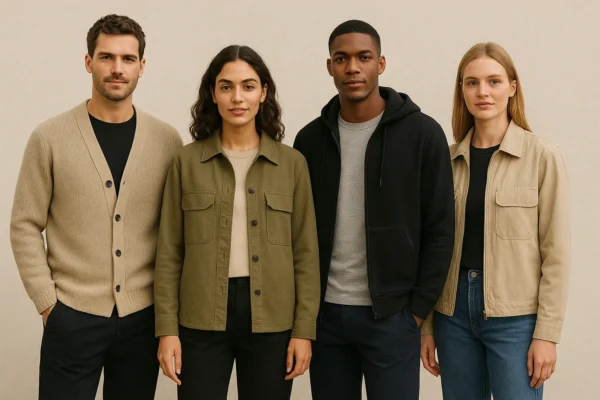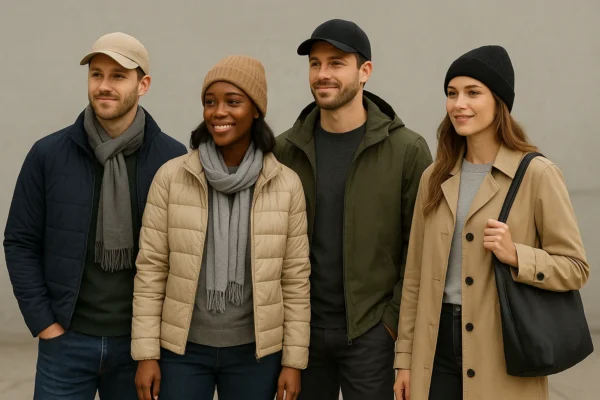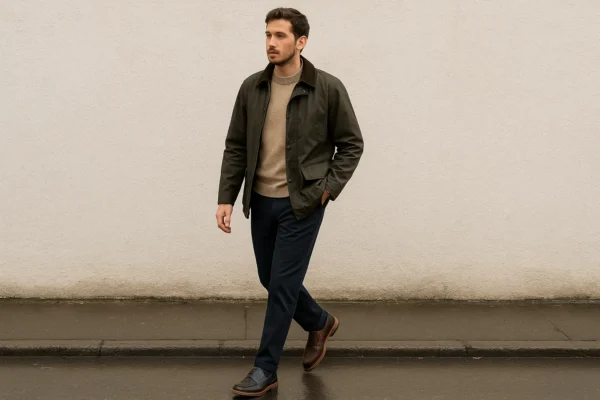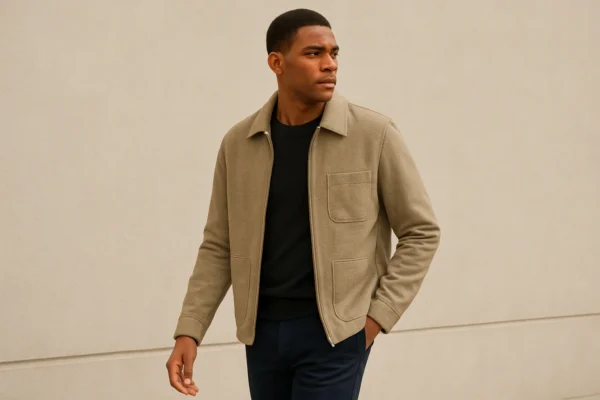Master Transitional Dressing: Tips to Stay Athletic & Fashion-Forward
Dressing during transitional seasons—when mornings feel chilly, afternoons heat up, and evenings cool down again—can be surprisingly tricky. Too many layers leave you sweating by noon, but too few have you shivering by sunset. The key is finding the right balance between comfort, flexibility, and style. That’s where athletic-inspired fashion shines.
Blending performance fabrics with smart layering techniques lets you adapt to changing temperatures without sacrificing your look. Whether you’re heading to the gym, commuting, or grabbing a coffee, you can stay ready for anything. With the right strategy, your outfit can transition as smoothly as the weather. In this guide, we’ll break down how to stay both athletic and fashion-forward, no matter what the forecast throws your way.
Layer Smarter: Building the Perfect Transitional Outfit
Layering is the foundation of transitional dressing. When temperatures shift throughout the day, the right combination of layers keeps you comfortable without constantly changing clothes. But layering isn’t just about piling on pieces, it’s about making smart choices that balance function and style. Here’s how to do it right:
Start with a Breathable Base Layer
The base layer sits closest to your skin, so comfort is non-negotiable. Choose moisture-wicking fabrics like lightweight cotton, merino wool, or performance blends that help regulate temperature. These materials pull sweat away from the body, keeping you dry when it’s warm and insulating when it’s cool. A fitted T-shirt or long-sleeve tee in neutral tones works well as a starting point for almost any outfit.
Select a Versatile Mid-Layer
Your mid-layer is where warmth meets style. Go for something lightweight and easy to remove, like a hoodie, zip-up sweatshirt, light sweater, or even a cardigan. This layer should add warmth without bulk, allowing your outfit to stay sleek and flexible. Choose pieces with stretch or breathable materials so you’re not overheating during midday temperature spikes.
Athleisure favorites—like a performance hoodie or soft fleece—are ideal for moving from gym to street without compromising on comfort or appearance.
Choose a Functional Outer Layer
Your outer layer should do more than look good, it should protect you. Opt for jackets that offer wind or water resistance, like a light trench, utility jacket, or even a denim jacket with inner lining. These pieces add structure to your outfit while helping you stay dry and warm when the weather shifts. Look for designs with zip fronts, adjustable cuffs, or ventilation panels for added flexibility.
This outer layer is often the most visible, so it’s a great place to showcase your style while staying weather-ready.
Layer by Feel: Mixing Fabrics and Colors for Transitional Dressing
Transitional dressing isn’t just about stacking layers, it’s about choosing pieces and materials that work together, both functionally and visually. When you combine the right textures and tones, your outfit doesn’t just adapt to changing temperatures, it stands out in a subtle, effortless way. Here’s how to get it right:
Mix Fabrics Mindfully
Pairing different fabrics isn’t just a style choice, it’s key to staying comfortable throughout the day. Lightweight cotton, linen, and jersey provide breathability, making them ideal for base layers or warmer hours. In contrast, heavier knits like fleece, French terry, or lightweight wool add insulation without overwhelming your look.
For example, you could wear a cotton T-shirt under a soft-knit hoodie, then top it with a structured utility jacket. The mix of textures not only helps regulate body temperature but also gives your outfit a more polished, layered appearance.
Athletes and activewear brands often rely on this principle, combining performance fabrics with cozy layers to balance function and feel.
Build a Seasonless Palette
Color plays a bigger role in transitional dressing than you might think. A solid foundation of neutral tones—like black, white, beige, gray, and navy—makes it easy to layer without clashing. These colors also feel timeless, making each piece more versatile across seasons.
To add warmth and visual depth, consider introducing a few autumn-inspired shades like olive green, burgundy, rust, or mustard. These tones pair beautifully with neutrals and give your outfit seasonal character without limiting its wearability.
The result? A wardrobe that looks intentional and stays relevant whether it’s early fall or late spring.
Easy Outfit Formulas for Transitional Weather
When the weather can’t decide what it’s doing, having go-to outfit formulas makes dressing easier and way more stylish. Transitional dressing doesn’t mean you need a closet full of new clothes. It’s about combining what you already have in smart, adaptable ways. Whether you’re heading to the gym, running errands, or grabbing coffee with friends, these formulas help you stay comfortable and pulled together.
Sporty Outfit Formula
Start with a lightweight base layer—a breathable T-shirt or moisture-wicking long sleeve tee works well. Add a mid-layer, such as a zip-up hoodie or overshirt, for insulation without the bulk. Finally, top it off with a breathable outer layer like a windbreaker, light trench, or even a water-resistant shell if the forecast calls for it.
Footwear depends on your activity. For casual outings or city errands, go with sleek athletic sneakers. For outdoor or rugged environments, lightweight boots or trail-inspired runners offer better support while keeping the look sporty.
The goal is to look ready for movement but also polished enough to go from park to café without needing a wardrobe change.
Smart Casual Sporty Looks
Want to elevate your sporty outfit without losing the relaxed vibe? Swap joggers for tailored pants, cargo trousers, or even wide-leg jeans for a more structured silhouette. On top, stick with breathable basics like a ribbed tee or performance top, then layer a hoodie under a denim jacket or a utility jacket for that high-low balance.
This combo keeps the comfort of activewear while adding a street-ready edge that works for casual meetings, brunch, or weekend outings. Keep accessories minimal—think clean sneakers, a sleek crossbody, or a cap—to tie everything together.
It’s the kind of outfit that looks like you didn’t try too hard… but you definitely did.
Accessories and Footwear for Transitional Weather
Consider Layering Accessories
Accessories during transitional months aren’t just for style, they’re functional. Lightweight scarves, for example, add just enough insulation around your neck during a chilly morning commute, and can be easily removed or tucked into a bag as the day warms up. Go for breathable materials like cotton or modal blends that don’t feel stuffy.
Caps and beanies are also practical add-ons. A structured cap gives off a sporty, clean vibe while shielding you from unexpected sun, whereas a light knit beanie offers warmth without overheating.
And don’t overlook socks—a simple switch from no-shows to midweight crew socks can make sneakers or ankle boots more transitional-weather friendly.
Pick Versatile Footwear
Your shoes are one of the most important parts of any transitional outfit. They need to keep up with shifting weather while still matching the rest of your look. That’s where structured sneakers, ankle boots, or even loafers with rubber soles come in.
- Structured sneakers (like leather or mesh-rubber hybrids) provide support and hold up better in light rain than soft canvas styles.
- Chelsea or chukka boots in waterproof suede or treated leather strike a perfect balance between casual and polished.
- Loafers or slip-ons with a solid sole offer breathability and dress things up a bit—great for smart-casual looks that stay weather-appropriate.
Each of these options works across various outfits—from athletic to elevated casual—making them worth the investment during unpredictable months.
Stay Ready: Everyday Tips for Smart Transitional Dressing
Transitional dressing is all about being prepared and looking good while you’re at it. Because weather can change from cool to warm (and back again) in a matter of hours, you need a wardrobe strategy that keeps up without making you feel overdressed or underprepared. These everyday tips will help you stay stylish and adaptable, no matter what the day brings.
Keep Essentials Layered & in Rotation
Start by building a small rotation of versatile, season-proof pieces you can rely on. Neutral cardigans, lightweight jackets, overshirts, zip hoodies, and breathable base layers are your go-to players during transitional months. These can be mixed, matched, and layered based on your needs—allowing you to pivot between cool mornings and warmer afternoons without starting from scratch.
Stick to neutral colors like black, beige, navy, or olive for maximum outfit flexibility, and add a few texture variations (like cotton, twill, or performance fleece) to keep things interesting. Think of these staples as your transitional “uniform”—easy to style, comfortable to wear, and quick to swap in or out.
Watch the Forecast and Adapt
It sounds simple, but a quick glance at the daily forecast can be the difference between a practical outfit and a regretful one. Pay attention not just to temperature, but also humidity, wind, and chance of rain. This helps you decide whether to bring that windbreaker, switch your loafers for waterproof sneakers, or toss a beanie in your bag.
You don’t need to overthink your look—just be prepared to adjust. For example, wearing a long-sleeve base layer under a hoodie gives you flexibility to remove one without sacrificing comfort. Or packing a packable jacket in your tote means you’re ready if the weather turns.
Staying flexible doesn’t mean sacrificing style. It means dressing with intention—while still giving yourself room to move, change, and respond to whatever the day throws your way.
Wrap-Up: Flex Your Style Through Every Season
Staying stylish and sporty in transitional weather isn’t about having more clothes, it’s about having the right ones. Mastering layers, picking breathable and versatile fabrics, and using accessories with purpose can completely transform how you navigate changing temperatures. A well-balanced outfit keeps you comfortable whether you’re facing cool mornings, warm afternoons, or unexpected wind or rain.
Don’t be afraid to experiment—layer that hoodie under a trench, try sporty sneakers with tailored pants, or mix textures like fleece and twill. With a few key staples and a little planning, your wardrobe can be as flexible as your day demands.
The best part? Transitional dressing gives you the freedom to blend style and function in creative, everyday ways.













